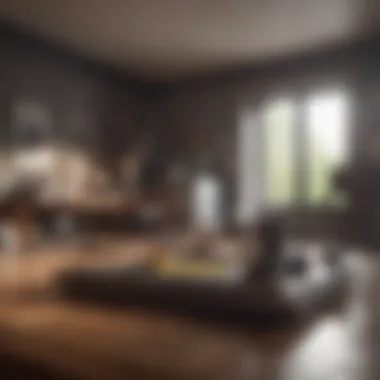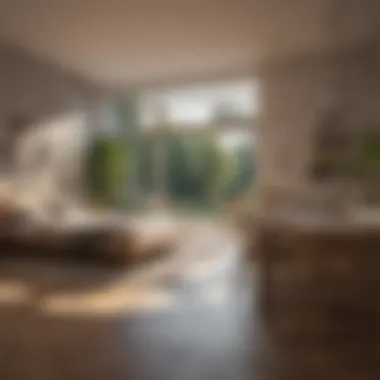Mastering Room Area Calculations for Design


Intro
Calculating the area of a room is fundamental in interior design, architecture, and home renovation. Accurate measurements contribute significantly to enhanced functionality and aesthetics. This process requires both technique and the right tools to ensure precision.
In this article, we will explore the methods for calculating room area effectively. We will delve into various shapes of rooms, discuss special considerations for irregular spaces, and highlight the tools that can streamline this process. Whether you are an architect, interior designer, or a homeowner, grasping these concepts is essential.
Home Design Inspiration
Exploring different aspects of home design can provide fresh ideas on how to utilize space more effectively. Understanding architectural styles and innovative decor trends can inspire new ways to design rooms while considering their area.
Architectural Styles
Different architectural styles have unique characteristics and spatial demands. For instance, modernist designs typically focus on open spaces and minimalism. Conversely, traditional designs may emphasize delineated rooms and detailed moldings. Recognizing these styles can guide area calculations for better alignment with design principles.
When calculating the area, consider how each architectural style influences space utility. For example, an open-plan kitchen-living area may require a different approach to area measurement than a series of small, dedicated rooms.
Innovative Decor Trends
In recent years, innovative decor trends have emerged, pushing the boundaries of space utilization. Minimalism remains popular, yet biophilic design, emphasizing nature in interiors, is rising in favor. Incorporating greenery into a room can influence how space is perceived and utilized, thus impacting area calculations.
Consider the furniture layout and decor elements as part of the calculation process. The inclusion of large plants or furniture can create a feeling of space limitation despite the actual area. In contrast, strategically placed mirrors can give an illusion of spaciousness, hence affecting the functional area.
"Understanding room shapes and sizes allows interior designers to maximize the potential of any space." — Unknown
Tools and Techniques for Area Calculation
In the realm of room design, tools and techniques are paramount for accurate area calculations. From measuring tapes to digital tools, each has its place in ensuring precision.
Measurement Techniques
Using a standard measuring tape remains the most common technique. However, for larger spaces or unique shapes, consider using a laser distance meter. This tool can provide quick and accurate measurements, minimizing errors.
For complex areas, breaking down the space into simpler shapes (rectangles, squares, triangles) can facilitate easier calculations. Then, sum the areas of these individual shapes for the total room area.
Special Considerations for Irregular Spaces
When dealing with irregularly shaped rooms, more attention is needed. In these cases, note any alcoves, nooks, or overhangs that may affect calculations. Such features require careful measurement to ensure no area is overlooked.
A sketch may be beneficial, providing a visual representation that aids in precision. Marking important dimensions on paper can simplify the calculation process.
Applications of Area Calculations in Design Planning
Understanding area calculations directly influences the design planning of spaces. For example, determining the correct scale for furniture is crucial. Oversized furniture in a small room can overpower the space, leading to a cramped feel.
Furthermore, knowledge of area helps in the selection of decor. Knowing the area can determine what wall art, lighting, and decoration pieces fit best. This allows for functionality while maintaining aesthetic appeal.
Prelims to Room Area Calculation
Calculating the area of a room is a fundamental aspect of design and planning. Accurate measurements are essential for a multitude of reasons. They influence design decisions, determine the amount of materials required, and contribute to overall space efficiency.
When designing a space, understanding the area is more than just knowing dimensions; it’s about enhancing functionality and visual appeal. A room's area can dictate the arrangement of furniture, dictate traffic flow, and affect acoustics and lighting. Without precise area calculations, one risks creating a space that is not only poorly functional but also aesthetically unpleasing.
Significance of Area Measurement
Area measurement is crucial because it lays the groundwork for effective interior design.
- Layout Design: A well-measured area allows designers to create layouts that optimize space, ensuring essential elements are included seamlessly.
- Material Estimation: Calculating the area helps in determining how much flooring, paint, or wallpaper is needed, thereby reducing waste and ensuring cost efficiency.
- Compliance and Safety: Certain legal standards must be adhered to in construction and renovation. Understanding area calculations ensures compliance with these regulations, contributing to safety and livability.


The importance of precisely measuring room area cannot be overstated. As both professionals and homeowners engage in planning and executing designs, the implications of area measurements will extend beyond mere numbers. Understanding these calculations empowers better design choices and ultimately leads to more harmonious living spaces.
"In the realm of design, the precision in area calculation paves the way for creativity and functionality to work hand in hand."
In summary, mastering the skill of area calculation is imperative for anyone involved in design, renovation, or real estate. It is an investment in the future use and appreciation of a space, ensuring that it not only serves its purpose but also embodies an appealing design.
Fundamental Concepts of Area
Understanding the fundamental concepts of area is essential for effective room design. This section provides clarity on what constitutes area and how it can be quantified. For anyone involved in real estate, interior design, or home improvement, grasping these concepts helps in making informed decisions related to space utilization and aesthetic design. Correct area calculation influences not only the layout but also the functionality of a space, facilitating the optimal arrangement of furniture and decor.
Definition of Area
Area refers to the extent of a two-dimensional surface measured in square units. It is a critical measurement when planning interiors and renovations. The mathematical calculation identifies how much space exists within defined limits, whether that be the floor of a room or a specific section of a wall.
In practical terms, knowing the area is vital for tasks such as selecting flooring materials, determining paint needs, or arranging furniture. The definition forms a foundation for calculating dimensions in various shapes, ranging from simple rectangles to complex irregular configurations. Understanding these aspects will help in making the most of the available space in a home or office setting.
Units of Measurement
Units of measurement are a crucial part of area calculation. The most commonly used units of area include:
- Square meters (m²) - Widely utilized in countries that use the metric system. It is advisable for large areas, such as entire rooms or buildings.
- Square feet (ft²) - Common in the United States and other countries using the imperial system. It's often used in residential properties.
- Square yards (yd²) - Typically employed in specific applications, such as landscaping or larger exterior areas.
Each unit serves a different need, and the choice depends on local standards and the scope of the project. As for using formulas to compute area, familiarity with units can aid in converting measurements accurately, ensuring that all calculations remain consistent and reliable throughout the design process.
"Understanding units and their conversions can eliminate potential errors in measurements, making your design process smoother and more efficient."
Engaging in accurate measurement practices ensures your design projects maintain precision, leading to satisfying and well-executed results. It allows real estate enthusiasts and interior design aficionados to capitalize on every inch of space, aligning function with seamless aesthetics for their desired environments.
Tools Required for Measurement
Area calculation is fundamental in room design. Accurate measurements are critical for creating functional and aesthetically pleasing spaces. To achieve such accuracy, appropriate tools are essential. This section outlines the tools needed to measure room areas effectively.
Measurement Instruments
Measurement instruments are crucial for precise area calculation. They come in various forms, each suited for different purposes. Some common instruments include:
- Tape Measure: This is the most basic tool used for measuring distances. A quality tape measure can extend to long lengths and is versatile for both indoor and outdoor use. It usually includes measurement markings in both metric and imperial units.
- Laser Distance Measurer: This modern device provides quick and precise measurements. Using laser technology, it can measure distances up to several hundred feet with minimal effort. This is particularly useful for larger spaces where traditional tape measures may be unwieldy.
- Wheel Measuring Tool: This tool is optimal for long distances. It consists of a wheel that rolls along the floor, counting the distance as it moves. It is ideal for measuring area in large outdoor spaces where tape measurements may not be practical.
These instruments, combined with careful measurement techniques, can help ensure that the area calculated is as accurate as possible.
Digital Tools Available
Digital tools are becoming increasingly popular for area measurement due to their accuracy and ease of use. These tools allow for more streamlined processes and often integrate with design software. Several noteworthy digital options are:
- Mobile Apps: Various apps are available for smartphones, enabling users to measure rooms using the phone’s camera. Some of these apps leverage augmented reality to assist in taking measurements quickly and efficiently. Examples include "MagicPlan" and "RoomScan Pro."
- CAD Software: Programs like AutoCAD or SketchUp allow users to create accurate models of floor plans where they can input measurements directly. The software can calculate areas automatically, saving time and reducing the potential for human error.
- 3D Scanners: These devices capture the complete geometry of a room. When connected to compatible software, they can create accurate 3D models, making them suitable for professional designers and architects looking for precision in their work.
"Accuracy in measurement is the foundation of all successful design efforts."
Equipping oneself with the right tools means possessing the confidence to tackle any room design challenges.
Methods to Calculate Area
Calculating area is a fundamental step in room design. Understanding various methods for area calculation allows designers and homeowners alike to make informed decisions about space usage. This knowledge not only assists in effective planning but also aids in maximizing the utility and aesthetics of any given space. Each method has its own set of considerations that can greatly influence the design process, making it critical to choose the right approach based on the room's shape and dimensions.
Calculating Area of Rectangular Rooms
To calculate the area of a rectangular room, the process is straightforward. The formula used is:


Area = Length × Width
- Measure Length and Width: Use a reliable measuring instrument like a tape measure. Ensure both measurements are in the same units.
- Perform Calculation: Multiply the length by the width. For instance, if a room is 12 feet long and 10 feet wide, the area will be 120 square feet.
The simplicity of this method makes it highly efficient and applicable to many common room shapes. Yet, accuracy in measurement is crucial to avoid future complications in design or furnishings fitting into the area.
Area Calculation for Square Rooms
Calculating area for square rooms closely resembles that of rectangular rooms but involves a single measurement.
Area = Side × Side
- Measure One Side: Since all sides of a square are equal, only one measurement is necessary.
- Square the Measurement: If the side of the room measures 10 feet, the calculation will be 10 × 10, resulting in an area of 100 square feet.
This method is particularly straightforward and effective for rooms where corners and walls are uniformly aligned, simplifying both measurements and calculations.
Calculating Area of Triangular Spaces
Calculating the area of triangular rooms requires a different approach compared to rectangular and square rooms.
Area = (Base × Height) / 2
- Determine the Base and Height: Measure the length of the base and the perpendicular height from the base to the opposite vertex. Ensure measurements are consistent.
- Apply the Formula: For example, if the base is 8 feet and the height is 5 feet, the area will be (8 × 5) / 2, yielding an area of 20 square feet.
This method provides a solid understanding of triangular shapes, which may be common in modern architecture but often present challenges in spatial design.
Irregular Room Shapes and their Areas
For irregularly shaped rooms, area calculation can be complex. These spaces often require breaking the room down into simpler shapes.
- Divide into Standard Shapes: Break the irregular shape into recognizable patterns, such as rectangles, squares, or triangles.
- Calculate Individual Areas: Use the methods mentioned above to calculate the area for each section.
- Sum the Areas: Add all calculated areas together to get the total area of the irregular shape.
This approach may take more time, but it ensures accuracy. It is important to be meticulous in measurements to mitigate discrepancies that may arise from complex angles or curves.
When dealing with irregular shapes, consider using grid paper or area calculators to visualize dimensions accurately.
Understanding these methods for area calculation will significantly enhance the design process and ensure better planning and execution of interior layouts.
Special Considerations in Area Measurement
When measuring the area of a room, attention to certain specific factors can significantly impact the accuracy of the results. Special considerations in area measurement address elements often overlooked during the process. These considerations are crucial for achieving precision, and they include handling alcoves, niches, and the influence of ceiling height on overall design decisions. Understanding these aspects helps ensure that design plans are based on actual usable space rather than potentially misleading measurements.
Dealing with Alcoves and Niches
Alcoves and niches are common architectural features in many homes. These recesses can provide unique design opportunities; however, they can also complicate area calculations. To accurately include them in your measurements, follow these guidelines:
- Measure Depth and Width: Determine the dimensions of the alcove or niche separately from the main room dimensions. This ensures you factor in all available space.
- Include in Room Calculations: When computing the total area, add the alcove as a distinct section. For example, if an alcove is 3 feet deep and 5 feet wide, its area is 15 square feet.
- Consider Usage: Reflect on how you plan to utilize these spaces. Space used for shelving might influence how you think about design, while a simple decorative niche might not significantly alter overall functionality.
Remember, overlooking alcoves and niches could result in an incomplete understanding of the available space, limiting your design options.
Ceiling Height in Area Calculations
Ceiling height is another crucial factor that deserves consideration during area measurement. It affects the perceived spaciousness of a room and can influence various design choices:
- Affects Perception: Higher ceilings usually make a room feel more spacious, while lower ceilings can create a sensation of confinement. This perception may impact furniture choices and overall design themes.
- Volume Calculations: While area is primarily a two-dimensional measurement, understanding how ceiling height fits into the space could help adjust design expectations. In certain instances, such as in the case of renting or buying spaces, volume might be discussed, especially for multi-level properties.
- Lighting and Ventilation: Spaces with higher ceilings may accommodate different types of lighting fixtures and ventilation options, altering how you design the space. Consider whether these elements will affect your area measurements indirectly.
Accurate area measurements account for both the floor and the vertical space to create a functional and appealing environment.


By recognizing these considerations, planners and homeowners can make more informed decisions, ensuring that their area calculations yield practical results for successful room designs.
Applications of Area Calculations
Understanding the applications of area calculations is crucial for anyone engaged in room design, whether as a professional or a homeowner. The accuracy of these calculations directly influences decision-making across various design elements. Proficient area measurement equips individuals with the ability to maximize functionality, enhance aesthetics, and ensure that space is utilized effectively. Here, we delve into three key applications: interior design considerations, functionality and space planning, and estimation for material needs.
Interior Design Considerations
Area calculations serve as the foundation for effective interior design. An accurate understanding of the space allows designers to curate the right mood and functional layout. Key elements include:
- Furnishing Arrangements: Knowing the area helps in deciding the appropriate size and number of furniture pieces. Oversized furniture in a small room can make it feel cramped, while too little furniture in a large space might render it impractical.
- Color Schemes and Textures: Designers often select colors and textures based on the perceived sense of space. A larger area may benefit from darker colors or intricate textures, which can create a cozy vibe, while smaller areas might call for lighter tones to enhance brightness.
- Traffic Flow: An understanding of the space allows designers to anticipate how individuals will move through an area. This is essential for creating an efficient and comfortable layout.
Functionality and Space Planning
Functionality is paramount in effective space planning. Area calculations help designers and homeowners balance aesthetics with practical use. Consider these aspects:
- Versatile Spaces: Understanding the total area aids in defining multifunctional spaces. A living room may also serve as a workspace, and optimal measurements can promote a seamless transition between the two.
- Zoning Areas: Accurate measurements allow for distinct zones within a room. For example, creating a reading nook in a larger living area can provide a sense of separation and purpose.
- Adaptable Design: With accurate area data, projects can adapt to the client's changing needs, ensuring the space remains functional over time.
Estimation for Material Needs
Calculating the area is also integral in estimating material requirements for flooring, painting, and furnishing. This estimation has multiple benefits:
- Budgeting: Accurate area measurements allow for a more precise budget, minimizing the risk of overspending on unnecessary materials.
- Resource Management: Knowing the right quantity of materials reduces waste and ensures efficient use of resources. This can significantly impact both the project's cost and its environmental footprint.
- Project Planning: Timely estimation helps in scheduling deliveries and installations, contributing to a smoother workflow and reducing project delays.
Effectively applying area calculations results in better-designed spaces that enhance both beauty and function.
In summary, the applications of area calculations are far-reaching. From effectively planning interior designs to ensuring functional spaces, and estimating material needs, understanding area plays a pivotal role in informed decision-making. Each aspect contributes to a successful design outcome, making it essential for anyone involved in room planning.
Challenges in Area Measurement
Measuring area accurately presents numerous obstacles that can significantly affect the outcome of design projects. Understanding these challenges is essential for anyone involved in interior design, renovation, or real estate. Area measurement is not simply about obtaining dimensions—it involves a keen awareness of various factors, such as shape, obstructions, and even psychological factors influencing space perception. Each of these aspects contributes to the potential inaccuracies that can arise during measurement.
Common issues can lead to flawed calculations. For instance, poor understanding of the shapes being measured can cause the individual to misapply formulas. Additionally, improper tool usage or lack of familiarity with the instruments can exacerbate these errors. Recognizing these challenges allows designers and homeowners to take proactive measures to avoid costly mistakes.
Common Mistakes in Measurement
When measuring a room to calculate its area, certain errors frequently occur. Here are some notable mistakes:
- Omitting Fixed Elements: Ignoring built-in features like closets, doors, and windows can lead to underestimating or overestimating usable space.
- Measurement Overlap: Misaligned measuring tapes can result in double counting certain dimensions. This is especially common in irregularly shaped rooms.
- Rounding Errors: Quickly rounding measurements can lead to inaccuracies. It is important to maintain precision in these calculations.
- Inconsistent Units: Failing to standardize measurements can create confusion, especially if one is switching between metric and imperial units.
To mitigate these mistakes, one can develop a systematic approach to measuring that includes reviewing calculations multiple times. Training and practice with measuring tools will also enhance precision.
Addressing Measurement Inaccuracies
Inaccuracies in area measurement can arise from various sources—improper technique being the most common. Here are several strategies for addressing these inaccuracies:
- Utilize Quality Tools: Always use reliable measuring devices. Opt for tape measures which are easy to handle and read, or consider digital measuring devices for more complex tasks.
- Double Check Calculations: After obtaining measurements, repeat the process to verify accuracy. Discrepancies should be a sign to reassess measurements and calculations.
- Reference Current Standards: Familiarity with standard measurement practices can help clarify complexities in area measurement.
- Consult Experts When Necessary: If in doubt, reaching out to professionals can provide insight and assurance in measurements being accurate.
Important Note: Accurate area measurements are critical to achieving the desired function and aesthetics of a space. Attention to detail in this phase can save time and resources in the long run.
Understanding these challenges in area measurement empowers individuals in the design process, leading to better outcomes and more functional spaces.
Finale and Future Considerations
The conclusion of any discussion on area calculation is crucial. It encapsulates the significance of accurate area measurements in room design and emphasizes the ongoing nature of learning within this subject. As room designs evolve, so do the methods and tools used in area calculation. Therefore, understanding how to calculate area effectively lays the groundwork for improved design and optimal use of space.
Benefits and considerations related to area calculations include:
- Precision in Planning: Accurate area determination aids in precise planning. This results in better layout decisions and efficient use of resources. Each square foot matters in interior design, given the growing emphasis on functional spaces in modern living.
- Adaptation to Trends: As styles and requirements change, continuous learning ensures that design enthusiasts stay updated on the latest tools and techniques. Familiarity with software and measurement technology can provide significant advantages in professional and personal projects.
- Integration of Technology: The rise of smart home technologies can also influence area calculations. Understanding how these technologies impact space and environment is vital for future designs. This includes knowing how to integrate technology seamlessly into existing designs without compromising aesthetic appeal.
"Learning is a never-ending process. In the world of design, the more you know, the better choices you make."
To thrive in the field of interior design, one must embrace the mindset of continual improvement. This applies to understanding both space and the implications that come with design decisions. As we move forward, not only is mastery of calculations critical, but also the ability to adapt to changing environments and expectations.
Continuing education through workshops, online courses, and professional networks can enhance one's skill set and add to the overall experience.
In summary, recognizing the importance of continuous learning about area calculations will not only heighten your design capabilities but also prepare you for the advancements and changes that lie ahead. The landscape of design is ever-evolving; staying informed results in spaces that are not only beautiful but also functional.







